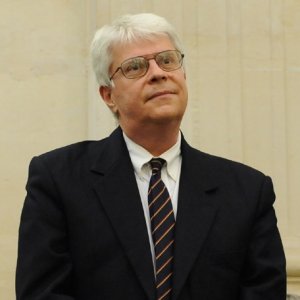Presented By: Aerospace Engineering
Chair's Distinguished Lecture: The Mechanics of Deformable Semiconductors: Theory and Application to PHV Cells in Bending
Solid Mechanics Laboratory (CNRS-UMR 7649) & Department of Mechanics, École Polytechnique, Aerospace Engineering Department & Mechanical Engineering Department, (Emeritus), University of Michigan, Ann Arbor

Solid Mechanics Laboratory (CNRS-UMR 7649) & Department of Mechanics, École Polytechnique, Aerospace Engineering Department & Mechanical Engineering Department, (Emeritus), University of Michigan, Ann Arbor
Since the early days of semiconductors, it is known that mechanical strains influence their electronic behavior. Consequently, a consistent modeling of the coupling between mechanical, electric and electronic properties of these materials is essential in predicting the effects of mechanical loading on the overall electronic response of semiconductor devices.
To this end, we first develop a general fully coupled mechanical, electrical and electronic continuum model of the finitely deformable semiconductors, which accounts for the strain-dependence of the band edge energies, densities of states and electronic mobilities. Governing equations are derived from the appropriate conservation laws using the direct approach (control volume) of continuum thermodynamics. It is found that there exist electronic-induced strains that can be an order of magnitude more than the electromagnetic-induced (Maxwell) ones.
Next, motivated by photovoltaics applications involving bending, we use asymptotic methods in conjunction with the proposed general theory to compute current-voltage characteristic of a p-n junction subjected to non-uniform strains. It is found that for a typical mono-crystalline silicon solar cell, the dark current changes are rather significant, of the order of 20% for strains of 0.2%. A series of recent experiments on uniformly strained photovoltaic p-n Si junctions, show that in spite of the highly complex phenomena involved, calculations give reasonable results.
About the Speaker
Prof. Triantafyllidis has obtained his Ph.D. in engineering from Brown University in 1980. The same year he joined the faculty of the Aerospace faculty of the University of Michigan in Ann Arbor, MI, USA from where he retired as emeritus Professor in the Departments of Aerospace Engineering and Mechanical Engineering & Applied Mechanics. In 2009 he moved to France to become CNRS Director of Research in the Solid Mechanics Laboratory (LMS) and a Professor of Mechanics at the Ecole Polytechnique of France.
His research is in the areas of stability in solids and structures, structural mechanics and nonlinear continuum mechanics. Over the years he has worked in sheet metal forming problems, large flexible space structures, composites and cellular materials, the geomechanics of the earth’s crust and stability issues in homogenization problems. More recently he worked on the thermomechanical stability of shape memory crystals. His recent interests are in multiphysics – i.e. problems involving interactions between mechanical, electromagnetic and electronic effects in solids – with applications in magneto-elasticity, electromagnetic forming, strain effects in semiconductors and flexible photovoltaics as well as in biomechanics.
Prof. Triantafyllidis has collaborated extensively with researchers on both sides of the Atlantic and has served, through different functions, the international solid mechanics community. His was awarded the Koiter Medal from the ASME and the Doisteau-Blutet Prize from the French Academy of sciences in 2010.
Since the early days of semiconductors, it is known that mechanical strains influence their electronic behavior. Consequently, a consistent modeling of the coupling between mechanical, electric and electronic properties of these materials is essential in predicting the effects of mechanical loading on the overall electronic response of semiconductor devices.
To this end, we first develop a general fully coupled mechanical, electrical and electronic continuum model of the finitely deformable semiconductors, which accounts for the strain-dependence of the band edge energies, densities of states and electronic mobilities. Governing equations are derived from the appropriate conservation laws using the direct approach (control volume) of continuum thermodynamics. It is found that there exist electronic-induced strains that can be an order of magnitude more than the electromagnetic-induced (Maxwell) ones.
Next, motivated by photovoltaics applications involving bending, we use asymptotic methods in conjunction with the proposed general theory to compute current-voltage characteristic of a p-n junction subjected to non-uniform strains. It is found that for a typical mono-crystalline silicon solar cell, the dark current changes are rather significant, of the order of 20% for strains of 0.2%. A series of recent experiments on uniformly strained photovoltaic p-n Si junctions, show that in spite of the highly complex phenomena involved, calculations give reasonable results.
About the Speaker
Prof. Triantafyllidis has obtained his Ph.D. in engineering from Brown University in 1980. The same year he joined the faculty of the Aerospace faculty of the University of Michigan in Ann Arbor, MI, USA from where he retired as emeritus Professor in the Departments of Aerospace Engineering and Mechanical Engineering & Applied Mechanics. In 2009 he moved to France to become CNRS Director of Research in the Solid Mechanics Laboratory (LMS) and a Professor of Mechanics at the Ecole Polytechnique of France.
His research is in the areas of stability in solids and structures, structural mechanics and nonlinear continuum mechanics. Over the years he has worked in sheet metal forming problems, large flexible space structures, composites and cellular materials, the geomechanics of the earth’s crust and stability issues in homogenization problems. More recently he worked on the thermomechanical stability of shape memory crystals. His recent interests are in multiphysics – i.e. problems involving interactions between mechanical, electromagnetic and electronic effects in solids – with applications in magneto-elasticity, electromagnetic forming, strain effects in semiconductors and flexible photovoltaics as well as in biomechanics.
Prof. Triantafyllidis has collaborated extensively with researchers on both sides of the Atlantic and has served, through different functions, the international solid mechanics community. His was awarded the Koiter Medal from the ASME and the Doisteau-Blutet Prize from the French Academy of sciences in 2010.